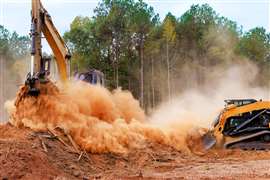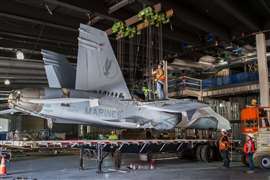A Moving Bauma
20 March 2008

Fully in line with the general trend in the construction industry, the highly specialized segment of manufacturers of trailers and transporters for heavy and oversize loads is breaking record after record.
This clearly underlines the importance and, to some degree, the growing importance of this segment in the construction industry in general. Both the growing size and weight of individual loads and the increasing volume of construction equipment in general requires state-of-the-art transport solutions. At the Bauma exhibition in April was one of the best examples, from Scheurle, with its set of modular trailers required to move the new Grove GTK1100 crane.
Nowadays heavy and specialized transport companies increasingly face pre-fabricated parts, pre-assembled units and even modularised loads that require new solutions.
Although no trailer manufacturers were exhibiting from outside Europe, many of the German and other European trailer manufacturers supply the world market, especially in hydraulic and modular trailers that have almost become the world standard for moving heavy to super heavy loads.
Leading manufacturer of hydraulic modular trailers, Scheuerle, used Bauma to launch its latest development: the SPMT 3000. This hydraulic modular trailer combines the advantages of the tractor-pulled InterCombi-range of conventional modular trailers with those of the 2.43 m wide SPMT. Scheuerle engineers integrated electronic multiway steering and hydrostatic drive into the 3 m wide trailer, without compromising platform height or capacity. In its lowest position the SPMT 3000 is 920 mm. It offers a lift of 300 mm to the standard driving height of 1,220 mm and an additional 350 mm lift to the highest platform level of 1,570 mm. The four- and six-axle line modules have eight wheels per line with a permitted axle load of 40 tonnes per line.
The relatively low height in combination with the 3 m wide deck and 1.8 m wheel track offers a high level of stability. The possibility to couple the SPMT 3000 to other types in the Combi range makes it an even more multi-functional and efficient trailer, although the maximum steering angle of those conventional trailers is restricted to 60 degrees. This product's first customer is RePower Systems, a wind turbine manufacturer.
Another member of the TII Group exhibiting on the same stand at Bauma was Nicolas from France. A number of new developments were presented, one of which was a joint-development with Scheuerle. The existing EuroCompact, specially aimed at road transport, has been redesigned and modified to reduce permit requirements to a minimum while at the same time optimising load length and capacity. This process, carried out in close co-operation with client Big Move from Germany, has resulted in the new EuroCompact Formula 7 (F 7). The new F 7 has a more compact two-line gooseneck dolly and rear bogie that results in a 460 mm length reduction to 17,190 mm. In combination with the 65 degree front and 60 degree rear dolly steering angle, the rear swing-out of the F 7 remains less than 1,100 mm. This allows for easy driving around roundabouts. In addition, the two-line dolly can be extended to a four-line one that increases load capacity to 99,630 kg.
Nicolas also introduced the MHD-RE, a self-propelled version of its highest capacity MHD hydraulic modular trailer that has multiway electronic steering. The MHD-RE allows coupling to the conventional MHD type, that restricts, however, the steering options to those of the mechanically steered ones. Recent clients for the MHD-RE include Lift ' Shift in India, ordering 48 lines, and the Saint Nazaire Shipyard, ordering 32 lines.
Nicolas reports strong sales in Italy and Spain of its light duty MDEL, heavy duty MDE and even the self-propelled MDE DM units and MDED modular trailers.
Displayed prominently and demonstrated to many during the day was Goldhofer's new PST/SLE. The self-propelled modular transporter (SPMT) has multi-way steering, integrated in the conventional THP/SL modular trailer. The PST/SLE even allows for coupling up with the mechanically steered THP/SL modular trailer, although steering will then be limited to the capabilities of the conventional trailers. The PST/SLE allows for 40 tonnes per axle line.
Also predominantly exhibited on the stand was the XLE 8, the five-bed-three plus neck extendable lowbed. A special feature, according to Goldhofer, is the patented maximum system length design of 23 m that, due to the steering characteristics, does not require a co-driver.
Stefan Fuchs, CEO of Goldhofer AG, claims that some 40 self-propelled units will be supplied this year and another 60 next year. That includes the third order for PST/SLE received from ZPMC in China Other significant moves in the the growing demand, Fuchs announced major investment in the Memmingen, Germany-based company consisting of a new 4,000 square metre production facility for semi trailers and a modern delivery shop. That will be needed as Goldhofer announced that it took direct orders worth more than Euro 10 million at Bauma.
Over the last three years Doll Fahrzeugbau has registered almost 50% growth in sales of heavy and specialized trailers. Originally the manufacturer specialized in trailers and trailer concepts for the logging industry. At Bauma Doll presented examples of its Vario range of trailers, including a four axle semi lowbed or step frame specially aimed at self propelled construction equipment. The Vario S4H-0 has a special gooseneck and a new generation of lightweight ramps. A three axle lowbed, the Vario T3H-S3F, was also on display featuring hydraulic steering, telescopic lowbed and hydraulically removable gooseneck. Doll also showed a special, the F4H-0S3, that comprises a four axle rear bogie and gooseneck. Instead of a lowbed construction equipment can, with some adaptations, be hung in between both ‘carriers’. Doll claims this system eases loading and discharging, has easy load securement and means considerable savings on permits. Later this year Doll will introduce a special three axle dolly for transporting wind turbine blades.
Meusburger, located both in Germany and Switzerland, specializes in niche products for the heavy and specialized transport market. One of those niches is the covered semi-trailer that can be widened to 3.50 m. It also has a roof that can be lifted 400 mm to allow loads up to 3.60 m tall to be loaded and carried fully covered. In this case the five axle semi-lowbed has been strengthened for 40 tonne point loads. Also, the side frames have been strengthened to offer sufficient stability.
Meusburger also produces a two axle covered lowbed that can accommodate loads up to 9 m long, 5 m wide and 4.050 m high. Although the lowbed is extendable the cover slides along. It also has a sliding roof to allow loading by crane. If weight requires, a third axle can be fitted to the rear temporarily. The Swiss-German company also supplies a range of non-standard semi lowbeds, including a special semi for access platforms and three axle 1.10 m high extendable flatbed trailers.
German manufacturer Langendorf presented the Flatliner SB 3, a so-called Innenlader. The U-shaped loading area allows for pallets to be carried inside the U. The two or three axle trailer, equipped with optional air or hydraulic suspension with a stroke of 400 mm, allows for self loading and discharging from the rear. This increasingly popular type of trailer, especially in the field of prefabricated (concrete) construction elements, allows loads up to 3.75 m high to be carried without overheight permit (at 4 m allowable height). A new feature of the Flatliner is the adjustable fifth wheel arm that now allows for a variable coupling height between 1.15 and 1.30 m. Also new is the three dimensional load securement system according to the stringent German VDE 2700ff regulations. The new generation of Innenladers is just one in several trailer categories produced by Langendorf.
Another manufacturer presenting a new Innenlader was Faymonville. The Belgium manufacturer, also based in Luxemburg and Poland, completely redesigned the Prefamax type to offer more stability, lower tare weight and consequently increased capacity, more ground clearance and better load securement.
Faymonville launched a new generation of Variomax lowbeds aimed at moving heavy construction plant equipment. The 4.5 to 7.5 m extendable excavator bed is available with up to five-axle rear bogies, up to three-axle modular dollies and an hydraulic gooseneck that is also designed for the new generation of five axle tractors.
The suspension consists of hydraulic swing type axles. A central main well through the rear bogie, 950 mm wide and 550 mm deep, allows for low positioning of the excavator arm. By adding an adaptor instead of the lowbed the trailer turns in to a semi lowbed. Transport of mobile equipment with limited ground clearance, like access platforms and lift trucks, is the target market for the new three axle Multimax N3LUB. Among other features, the trailer has hydraulic folding rear ramps and a 3 m deck section that offers access to the gooseneck.
Its brother, the N3LU Light, has been completely redesigned, resulting in a 20% tare weight reduction. According to the manufacturer this trailer is specially aimed at carrying barrels and road finishers.
In sight
The eye catcher from Broshuis was its new and innovative approach to more efficient transport of crane ballast and accessories. The Dutch manufacturer introduced its patented five axle, 40 foot (12 m) ballast trailer that can be split into two separate 20 (6 m) foot trailers. The trailer has been developed based on the popular 2CONnect container chassis introduced in 2003. This also explains the unprecedented weight-to-capacity ratio of 1:5.55. With a tare weight of only 9,300 kg loading capacity is 51,640 kg. The trailer has five 9 tonne SAF axles, of which three are self tracking and three can be lifted. Broshuis developed the new trailer with the requirements of mobile crane operators in mind. In congested city and site situations it becomes increasingly difficult to manoeuvre large ballast trailers to within safe reach of the crane. Splitting units up in short and easy to manoeuvre trailers is the answer, according to Broshuis. For crane companies operating their heavier cranes in a lower capacity range, with less ballast, it becomes more easy and efficient to split the trailer up and only carry the one with the required ballast configuration without the need for crane discharging and reloading. This, of course, requires some preparation but, in many cases, it is possible with the modular ballast configurations of almost all modern large capacity telescopic cranes. Broshuis also showed a three axle lowbed and a four axle extendablesemi lowbed.
Another Dutch trailer manufacturer, Nooteboom, displayed its full range of standard, specialized and heavy transport trailers. Special emphasis was on the latest development of the Pendel-X range of Euro lowloaders that has found its way in to large and heavy load movements. Nooteboom reports full order books, including 44 axle lines of InterCombi hydraulic modular trailers to be supplied to three heavy transport companies in the Netherlands - Nederhoff, van der Meijden and Lafeber. Nooteboom continues to operate a strategic alliance with Scheuerle with respect to hydraulic modular trailers.
Cometto from Italy displayed its range of trailers. At the heavy end of the range is the six axle line MSPE, a self-propelled modular transporter with electronic multi-way steering. The six line unit was in the red livery of Fagioli, which is said to have ordered a total of 100 lines of MSPE. Other modular trailers included the heavy Series 1MS, with eight wheels per line, and the medium capacity range Series 0, aimed at road haulage. In addition, Cometto displayed models from its ranges of lowbed, semi lowbed and extendable flatbed trailers.
Without doubt Bauma 2007 was one of the most successful ever. Although order books are more than full, talking to the manufacturers revealed that many are working hard on developing new trailers, concepts and expanding sales territory. First results and news will be published in IC soon. Final results in iron and on rubber will be on display in three years time on the 29th Bauma in 2010.




